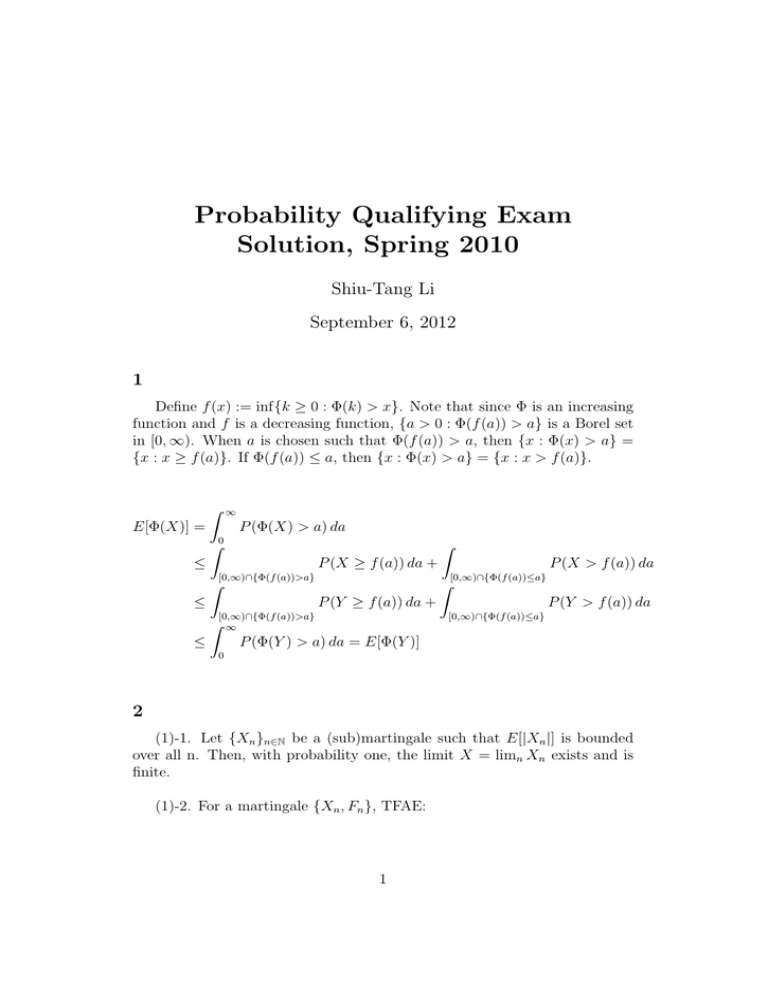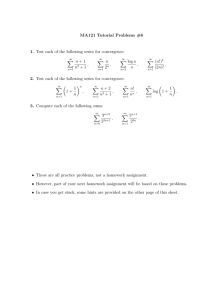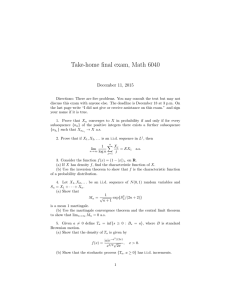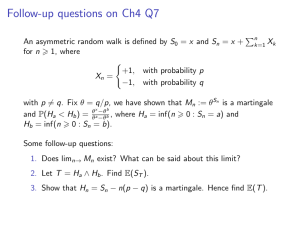Probability Qualifying Exam Solution, Spring 2010 Shiu-Tang Li September 6, 2012
advertisement

Probability Qualifying Exam
Solution, Spring 2010
Shiu-Tang Li
September 6, 2012
1
Define f (x) := inf{k ≥ 0 : Φ(k) > x}. Note that since Φ is an increasing
function and f is a decreasing function, {a > 0 : Φ(f (a)) > a} is a Borel set
in [0, ∞). When a is chosen such that Φ(f (a)) > a, then {x : Φ(x) > a} =
{x : x ≥ f (a)}. If Φ(f (a)) ≤ a, then {x : Φ(x) > a} = {x : x > f (a)}.
∞
Z
P (Φ(X) > a) da
E[Φ(X)] =
Z0
Z
≤
P (X ≥ f (a)) da +
P (X > f (a)) da
[0,∞)∩{Φ(f (a))>a}
[0,∞)∩{Φ(f (a))≤a}
Z
Z
≤
P (Y ≥ f (a)) da +
[0,∞)∩{Φ(f (a))>a}
Z ∞
≤
P (Y > f (a)) da
[0,∞)∩{Φ(f (a))≤a}
P (Φ(Y ) > a) da = E[Φ(Y )]
0
2
(1)-1. Let {Xn }n∈N be a (sub)martingale such that E[|Xn |] is bounded
over all n. Then, with probability one, the limit X = limn Xn exists and is
finite.
(1)-2. For a martingale {Xn , Fn }, TFAE:
1
(i) it is uniformly integrable.
(ii) It converges to X 0 a.s. and in L1 , and Xn = E[X 0 |Fn ].
(iii) It converges to X 0 in L1 , and Xn = E[X 0 |Fn ].
(iv) There is some X ∈ L1 s.t. Xn = E[X|Fn ].
(Note that the X 0 in (ii) and (iii) is the same one but is different from
the X in (iv).)
(2) For each n, E[E[Z|Fn ]|Fn−1 ] = E[Z|Fn−1 ], by the definition of conditional expectation, and hence {E[Z|Fn ], Fn } is a martingale. We observe
that
W∞
X = E[Z|F∞ ] satisfies E[Z|Fn ] = E[E[Z|F∞ ]|Fn ], where F∞ := n=1 Fn , so
by Doob’s martingale convergence theorem E[Z|Fn ] → Y a.s. and in L1 for
some Y , and E[Y |Fn ] = E[Z|Fn ] by the statements in martingale convergence theorem. We claim that Y = E[Z|F∞ ].
R
R
S∞
F
,
we
have
Y
dP
=
ZdP . The set {B :
For
any
A
∈
n
n=1
A
A
R
R
Y
dP
=
ZdP
}
is
a
λ-system
(The
monotone
class
property follows
B
B
S∞
from LDCT), which contains n=1 Fn , Rwhich is a Rπ-system that generates
F∞ . Thus by π − λ theorem we have A Y dP = A ZdP for A ∈ F∞ , so
Y = E[Z|Fn ].
3
First note that a +
enough, we have
1
λ
ln n > 0 for all n large. Therefore, when n is large
P (max(X1 , · · · , Xn ) ≤ a +
λa
1
1
ln n) = (1 − eλ(a+ λ ln n) )n
λ
e−λa n
= (1 −
)
n
λa
= e−e as n → ∞
Let F (a) = 1 − e−e . It is the distribution function of some r.v. X and
we conclude that max(X1 , · · · , Xn ) − λ1 ln n ⇒ X.
2
4
5
6
(a)
P (N = k; N1 < N2 ) = P (N1 = k; N2 > k)
= P (X1 = 3, · · · , Xk−1 = 3, Xk = 1)
− P (X1 = 3, · · · , Xk−1 = 3, Xk = 1; Xn 6= 2 for all n > k)
= P (X1 = 3, · · · , Xk−1 = 3, Xk = 1)
= pk−1
3 p1
2
= pk−1
3 (p1 + p2 ) · (p1 + p1 p3 + p1 p3 + · · · )
= P (X1 = 3, · · · , Xk−1 = 3, Xk 6= 3)
∞
X
P (X1 = 3, · · · Xn = 3, Xn+1 = 1)
×
n=0
= P (N = k)P (N1 < N2 )
(b)
E[N ; N1 < N2 ]
P (N1 < N2 )
E[N ]P (N1 < N2 )
=
P (N1 < N2 )
∞
X
nP (N = n)
=
E[N1 |N1 < N2 ] =
n=1
=
∞
X
np3n−1 (p1 + p2 ) =
n=1
1
1 − p3
(c)Let N1 be the numer of trials needed for 6 to appear, N2 be the numer
of trials needed for 7 to appear, N3 be the numer of trials needed for any
number other that 6 or 7 to appear. By (b), the conditional expected numer
1
of rolls is 11/36
= 36/11.
7
it
(a) The characteristic function φ(t)√ of X ∼ Poisson(λ)
is eλ(e −1) . The
√
p
it/
λ
−1) −iλ(t/ λ)
ch.f. of (X − EX)/ V ar(X) is eλ(e
e
. We observe that
3
√
it/ λ
lim λ(e
λ→∞
√
it/ λ
√
eit/λ − 1 − it/λ
− 1 − it/ λ) = lim
λ→∞
1/λ2
−iteit/λ /λ2 + it/λ2
= lim
λ→∞
−2/λ3
−iteit/λ + it
= lim
λ→∞
−2/λ
(it)2 eit/λ /λ2 + it
= lim
λ→∞
2/λ2
−t2
=
2
√
2 /2
−1) −iλ(t/ λ)
As a result, eλ(e
e
→ e−t
shown the desired weak convergence.
while λ → ∞, and we have
8
X
n 2 2
1
Xi Xj −
µ )]
E[ n (
2
2 1≤i<j≤n
2
X
X
X
n 2
n
4
X
X
]
−
2E[
X
X
]
µ
+
µ4 )
(E[
X
X
]E[
= 2
k
l
i
j
i
j
2
2
n (n − 1)2
1≤i<j≤n
1≤i<j≤n
1≤k<l≤n
X
X
4
= 2
(6E[
X
X
X
X
]
+
2E[
Xi2 Xj Xk ]
i
j
k
l
2
n (n − 1)
1≤i<j<k<l≤n
1≤i,j,k<l≤n,i6=j,j6=k,k6=i
2
X
X
n 2
n
2 2
+E[
Xi Xj ] − 2E[
Xi Xj ]
µ +
µ4 )
2
2
1≤i<j≤n
1≤i<j≤n
2
2
n 2 2
n
n
n
4
n 4
2
2
2 2
4
= 2
(6
µ
+
2
·
3
·
µ
(σ
+
ν
)
+
(σ
+
ν
)
−
2
µ
+
µ4 )
2
n (n − 1)
4
3
2
2
2
→ 0 as n → ∞
We have proved the L2 convergence of it and hence convergence in pr.
4
9
Let B, B 0 ∈ B(R).
Z
1{X1 ∈B 0 } dP = P (X1 ∈ B 0 , X2 + · · · + Xn ∈ B − B 0 )
{Sn ∈B}
= P (Xk ∈ B 0 , Sn − Xk ∈ B − B 0 )
Z
1{Xk ∈B 0 } dP
=
{Sn ∈B}
We thus have
m
m2
X
Z
{Sn ∈B} j=1
j
j−1 j
1
dP =
2m {X1 ∈[ 2m , 2m )}
m
m2
X
Z
{Sn ∈B} j=1
j
j−1 j
1
dP
2m {Xk ∈[ 2m , 2m )}
and let m → ∞ using the fact that E[X1 ] < ∞, we have
Z
Z
+
X1 dP =
Xk+ dP.
{Sn ∈B}
{Sn ∈B}
Similarly, we have
Z
X1−
Z
dP =
{Sn ∈B}
{Sn ∈B}
Xk− dP
For any 1 ≤ k ≤ n.
Therefore,
R
{Sn ∈B}
Xk dP =
R
{Sn ∈B}
X1 +···+Xn
n
dP , and thus E[Xk |Sn ] =
Sn
.
n
(b) Let Fk = σ(Sn , · · · , Sn−k+1 ).
Sn−k+1
|σ(Sn , · · · , Sn−k+2 )]
n−k+1
1
=
E[Sn−k+1 |σ(Sn−k+2 , Xn−k+3 , · · · , Xn )]
n−k+1
1
=
E[Sn−k+1 |σ(Sn−k+2 )] Since Xi0 s are independent.
n−k+1
1
Sn−k+2
=
(n − k + 1)
= Mk−1 .
n−k+1
n−k+2
E[Mk |Fk−1 ] = E[
Remarks. If σ(X, Y ) is independent if Z, then E[X|Y, Z] = E[X|Y ]. To
5
see this,
Z
Z
E[X|Y, Z] dP =
X dP
{Y ∈B1 ,Z∈B2 }
{Y ∈B1 ,Z∈B2 }
Z
= P (Z ∈ B2 )
X dP
{Y ∈B1 }
Z
E[X|Y ] dP
= P (Z ∈ B2 )
{Y ∈B1 }
Z
E[X|Y ]1{Z∈B2 } dP
=
{Y ∈B1 }
Z
E[X|Y ] dP.
=
{Y ∈B1 ,Z∈B2 }
10
Let a, b > 0, 0 < x < 1. Let p =
1
,q
1−x
= x1 , we have p + q = 1.
(1 − x) ln E|X|a + x ln E|X|b = ln(E[|X|a ])1−x E[|X|b ]x
≥ ln E[|X|a(1−x) |X|bx ] = ln E[|X|a(1−x)+bx ]
6






